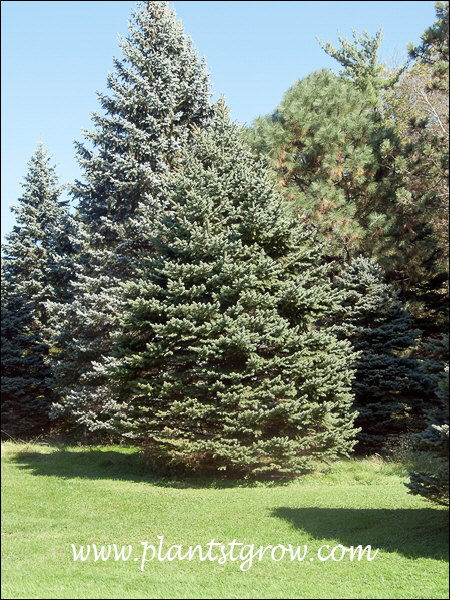| Description | A green version of the more popular Colorado Blue Spruce. |
|---|---|
| Pronunciation | (PY-see-uh)(PUN-gens) |
| Plant Type | All Plants, Trees Coniferous |
| Hardiness Zone | 3 |
| Sunlight | full |
| Moisture | average, doesn't like to be grown in hot dry sites |
| Soil & Site | prefers rich moist but is very adaptable |
| Fruit | cones, 2-4" long |
| Leaves | needles, 3/4" to 1.25" long, very stiff, green |
| Dimensions | The tree has strong apical dominance causing the formation of a conical shape. It reaches 30-60' tall by 10-20' spread in the landscape. In native sites it will get larger. Allow at least 10-12' from the center of the tree to any structure and looks best if planted in groups. |
| Maintenance | The secret to keeping this tree healthy and looking good is to prevent the bottom branches from being damaged by lawn mowers, weed whips, etc. Create a grass-less ring, extending one foot out from the tips of the branches. As the branches grow, expand the ring. One of the ugliest plants in the world is spruce with their bottom branches removed, creating the ice cream cone effect. |
| Propagation | seeds |
| Misc Facts | Pungens means "piercing" referring to the stiff needles. "Genus name is reportedly derived from the Latin word pix meaning pitch in reference to the sticky resin typically found in spruce bark". (#144) |
| Author's Notes | People just don't realize the potential size of these plants. Many times they are purchased as small, inexpensive plants and than planted to close to the driveway, side walk or house. I have seen Spruce planted between the sidewalk and the house. These plants are destined for the "chain saw". |
| Notes & Reference | #01-Manual of Woody Landscape Plants (Michael Dirr), #93-North American Landscape Trees (Arthur Lee Jacobson), #181-Native Trees for North America (Guy Sternberg), #144-Missouri Botanical Gardens web site (www.missouribotanicalgarden.org) |

Cart

